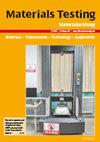Innovative prevention of stress corrosion crack propagation in nuclear power pipe welds
IF 3.5
4区 材料科学
Q2 MATERIALS SCIENCE, CHARACTERIZATION & TESTING
引用次数: 0
Abstract
Abstract Failure caused by stress corrosion cracking (SCC) is inevitable during the long-term service of nuclear power pipe welds. This is mainly due to the propagation of microcracks in the deposited metal, which seriously affects the operation safety of nuclear power pressure pipes. Overlay welding is practical for pressure pipe repair welding, which can introduce compressive residual stress inside the weld seam. In this work, a diagonal T-pipe joint was fabricated using tungsten inert gas arc welding with ERRS-3 wire, and an overlay weld was also fabricated using tungsten inert gas arc welding with ERRS-3 wire under circumstances of water in the pipe and no water in the pipe. And then the contour method and finite element method were employed to measure and calculate the residual stress distribution in the diagonal T-pipe joint. Both results showed that overlay welding can introduce compressive residual stresses into the pipe joint. The compressive residual stress zone area inside the weld seam with water in the pipe is larger than that without water in the pipe, and the compressive residual stress zone area varies at different positions of the weld seam. This work is expected to promote the application of overlay weld technology in the diagonal T-shaped pipe joint repair and prevent stress corrosion crack propagation of nuclear power pipe welds.核电管焊缝应力腐蚀裂纹扩展的创新预防
摘要应力腐蚀裂纹是核电管焊缝在长期使用中不可避免的失效。这主要是由于沉积金属中微裂纹的扩展,严重影响核电压力管的运行安全。堆焊是一种实用的压力管道修补焊,但堆焊会在焊缝内引入残余压应力。本工作采用ERRS-3焊丝采用钨惰性气体弧焊制作对角t型管接头,并在管中有水和管中无水两种情况下,采用ERRS-3焊丝采用钨惰性气体弧焊制作覆盖焊缝。然后采用轮廓法和有限元法对斜t管接头残余应力分布进行了测量和计算。结果表明,堆焊会使管道接头产生残余压应力。管内有水的焊缝内部残余压应力区面积大于管内无水的焊缝内部残余压应力区面积,且焊缝不同位置的残余压应力区面积不同。本工作有望促进堆焊技术在对角t型管接头修复中的应用,防止核电管焊缝应力腐蚀裂纹扩展。
本文章由计算机程序翻译,如有差异,请以英文原文为准。
求助全文
约1分钟内获得全文
求助全文
来源期刊

Materials Testing
工程技术-材料科学:表征与测试
CiteScore
4.20
自引率
36.00%
发文量
165
审稿时长
4-8 weeks
期刊介绍:
Materials Testing is a SCI-listed English language journal dealing with all aspects of material and component testing with a special focus on transfer between laboratory research into industrial application. The journal provides first-hand information on non-destructive, destructive, optical, physical and chemical test procedures. It contains exclusive articles which are peer-reviewed applying respectively high international quality criterions.
 求助内容:
求助内容: 应助结果提醒方式:
应助结果提醒方式:


